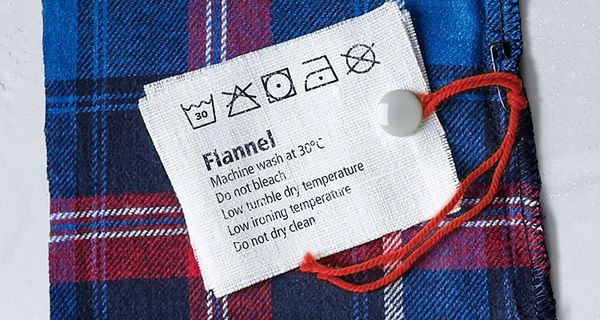
What do the washing symbols mean on your new clothes? Laundry labels contain loads of information, but once you understand the basic logic, they are easy to decipher.
Washing label symbols are divided into five basic categories : washing, drying, ironing, dry cleaning and bleaching. Different variations of the symbols provide detailed care instructions for each phase – always read them before switching on your washing machine .
You can find explanations for individual washing symbols below. Want a quick overview? Download and print our laundry symbol table :

General washing symbols.

|
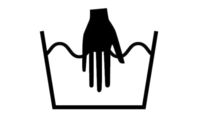
|
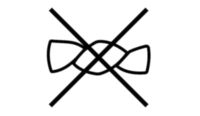
|
|
Do not wash Be careful whenever you see this symbol on your garments. Clothes with this washing symbol on the label are not machine-washable. Never place them in the washing machine – and do not wash them by hand. They most likely need dry cleaning (see below). |
Hand wash This washing symbol means that your garment may only be washed by hand. But don't worry, because many washing machines have hand-washing programmes that are just as gentle on your clothes. |
Do not wring If you see this symbol, you should resist the urge to twist and turn fabrics to remove excess water, because wringing could damage the fibres. Instead, gently press the fabric (or roll it into a thick towel) to remove water. |
Gentle wash, delicates and spin cycles.
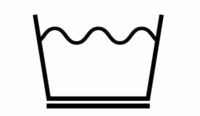
|
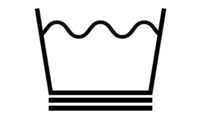
|

|
|
Permanent press cycle The washing symbol with a line or a dash under the tub means that the laundry can be washed with a shorter washing cycle (like a synthetic programme) and a short or low-speed spin cycle . A tub with no line means that your clothes are machine washable . You'll find this on more robust fabrics like denim . The correct washing temperature will usually appear inside the symbol (see below). |
Gentle cycle or delicates A washing symbol with two lines under the tub means your clothes need an extra-gentle wash. They should only be washed with a gentle programme (e.g. wool) and a suitable detergent. Avoid the spin cycle if possible. |
Gentle cycle with temperature A tub with one or more lines underneath and a temperature simply means that your garment should be washed gently at the prescribed temperature. Avoid the spin cycle if possible. |
Washing temperatures.

|
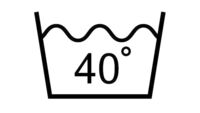
|

|
|
Wash at 30 degrees This laundry symbol means that your clothing may be machine-washed, but only at low temperatures of up to 30 degrees Celsius. |
Wash at 40°C or below Your garment can withstand washing temperatures of up to 40°C. |
Wash at 50°C or below If you see this washing symbol, washing can be done at temperatures of up to 50°C. |

|

|
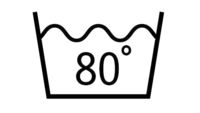
|
|
Wash at 60°C or below With this laundry symbol, your garment may be washed at temperatures up to 60°C. |
Wash at 70°C or below This washing symbol indicates that the laundry can be washed at up to 70°C. |
Wash at 80°C or below This washing symbol allows the washing of textiles at hot temperatures up to a maximum of 80°C. |
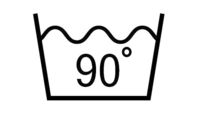
|
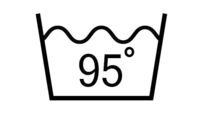
|
|
|
Wash at 90°C or below Your fabric or clothing piece can withstand extra-hot washing at up to 90°C. |
Washing at 95°C or below Your item can be machine-washed at the highest temperature: 95°C. |
American washing symbols.
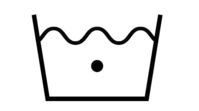
|
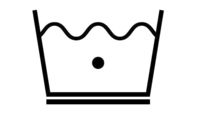
|
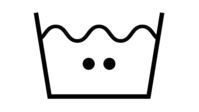
|
|
Wash at 30°C or below In the US, the tub symbol with a dot inside means that your laundry that can only be washed at 30 degrees Celsius or below. |
Gentle wash at 30°C or below If you're seeing an extra line below the tub symbol with a dot inside, that means your clothing should be washed using a gentle cycle. |
Wash at 40°C or below The washing symbol with two dots in the tub stands for laundry that can be washed at 40 degrees Celsius. |

|
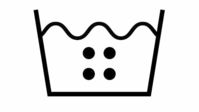
|
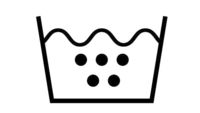
|
|
Wash at 50°C or below The tub symbol with three dots indicates laundry that can be washed at hot temperatures of up to 50°C. |
Wash at 60°C or below Care symbols with four dots indicate that items can be washed at a washing temperature of up to 60°C. |
Wash at 70°C or below Laundry that can be washed at up to 70 degrees is indicated in the United States by a tub symbol with five dots. |

The triangle or bleaching symbol usually comes after the tub symbol on a clothes label. It is important to know that bleaching can be done in two ways: Either with the help of oxygen or with chlorine. Each method has its own symbol. Here's an overview of all bleaching symbols:

|
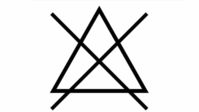
|
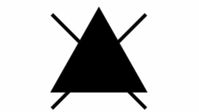
|
|
Bleach is allowed The triangle symbol on a laundry label means that any type of bleach is permitted. |
Do not bleach The crossed-out triangle washing symbol means that bleach is not allowed. If you find this symbol, make sure to use a good colour detergent, or one that doesn't contain any optical brighteners that will fade your clothes. |
Do not bleach This is an outdated version of the "do not bleach" symbol that you may still find on older items. |
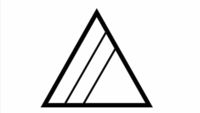
|
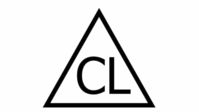
|
|
|
Non-chlorine bleach only Two diagonal lines inside the triangle mean that you may use bleach to brighten your clothes – just make sure that it's a non-chlorine variety. |
Chlorine bleach The letters CL in a triangle on the washing label stand for chlorine and mean that your garment may only be whitened using chlorine bleach. |

The ironing symbol on the laundry label speaks for itself – after all, it looks just like an iron. The symbol is often supplemented by dots that indicate the maximum ironing temperature . Find them all below.
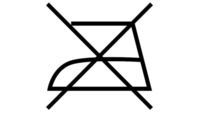
|
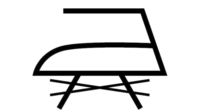
|
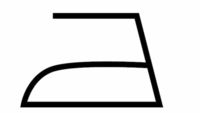
|
|
Do not iron A crossed-out iron symbol means that it is not safe to press your item with an iron, since ironing may permanently damage the fabric. |
Do not steam-iron If only the steaming portion of the iron is crossed-out, your garment may be ironed as long as you do not use the steam function. |
Ironing is allowed An iron is the general laundry symbol for ironing and means that ironing is suitable for your fabric. |
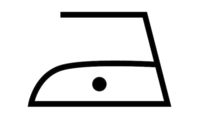
|

|

|
|
Iron at 110°C This iron symbol with a dot stands for extra-gentle ironing at a maximum of 110 degrees Celsius. |
Iron at 150°C The iron symbol with two dots indicates that the item can be ironed at a maximum temperature of 150°C. |
Iron at 200°C If the iron symbol has three dots, you can use a higher temperature of up to 200°C. |

An empty circle is the general laundry symbol for dry cleaning. Variations of this washing symbol provide information on how items of clothing can be professionally cleaned. Letters in the circle stand for the type of cleaning (wet cleaning, cleaning with petroleum solvents or any solvents, etc.).
As with the other laundry symbols, the lines or bars underneath specify the need for gentle care. A crossed-out circle indicates that the garment must not be dry-cleaned.

|
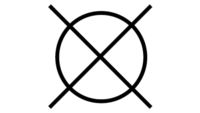
|
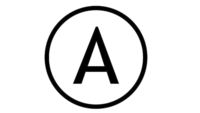
|
|
Dry clean The circle is the general symbol for dry cleaning. |
Do not dry clean A crossed-out circle means that dry cleaning is not permitted for an item of clothing. |
Dry clean, any solvent An "A" inside the dry cleaning symbol indicates that dry cleaning is possible with all dry cleaning solvents. |
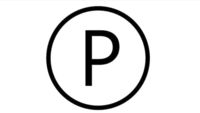
|
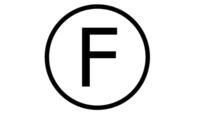
|
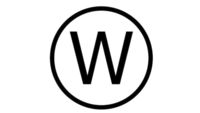
|
|
Dry clean, perchloroethylene (PCE) The letter P inside the dry cleaning symbol means dry cleaning can be done with PCE or petroleum-based solvents. |
Dry clean, petroleum solvents only The letter F inside the dry cleaning symbol means dry cleaning should only be done with petroleum solvents. |
Professional wet cleaning The dry cleaning symbol with the letter W stands for professional wet cleaning only. |

|
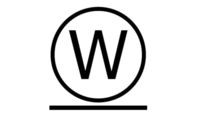
|
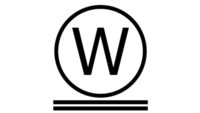
|
|
Cleaning method not allowed If any cleaning method is shown with a crossed out circle, it should not be used. |
Gentle professional wet cleaning A circle with the letter W and a line below it means your item requires gentle professional wet cleaning. |
Extra-gentle professional wet cleaning A circle with the letter W and two lines below it means that the laundry item requires extra-gentle professional wet cleaning. |

The square with a circle inside is the general dryer symbol. If this symbol appears on a laundry label, the garment can be dried in a machine, unless the square is crossed out. Different variations of this drying symbol provide information about the programmes and temperature settings at which laundry can be dried.
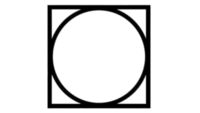
|
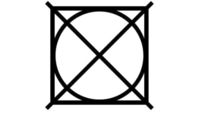
|

|
|
Tumble dry The square with a circle in the middle means that the item can go in your dryer. |
Do not tumble dry Clothing items that are not suitable for tumble drying are marked with an X symbol. Do not place these items in your dryer . |
Air drying A laundry care symbol in the form of a plain square without a circle stands for air drying. You should dry this laundry by hanging it on a (rotary) clothesline or a drying rack. |
Learn more about the most common dryer symbols and dryer programmes here:
Frequently asked questions about washing symbols and laundry symbols.
What should I do if the laundry symbol is missing?
If your label is missing or no longer legible, don't worry. Your garment's fabric will usually give you clues about the correct washing temperature and cycle. Common fabrics such as denim or jersey are easy to recognize and can easily withstand washing at up to 40 degrees. If you're still not sure, you can always refer to the care instructions for garments made from the same material.
Do the same symbols apply worldwide?
Washing symbols for laundry care are internationally standardized (ISO 3758: 2012) and were introduced by GINETEX (International Organization for Textile Care Labels) in 1963. Only South Korea and the USA do not use this system: in these countries there are different symbols, but they are also regulated by national laws and standards.
Why do I need to follow the washing symbols and instructions?
Washing care symbols help you give your garments the best care, so you'll be able to wear and enjoy them for longer. Not following the laundry care instructions on the label can cause your new dress or jumper to shrink, or your favourite blouse to fade.
Extra-delicate fabrics like wool or silk can be damaged if they are washed or ironed at high temperatures. But washing all your clothes at extra-low temperatures just to be on the safe side also isn't a good solution. On the one hand, some detergents are formulated to perform better at higher temperatures and, on the other hand, many items like undergarments should be washed at higher temperatures for hygiene reasons.
